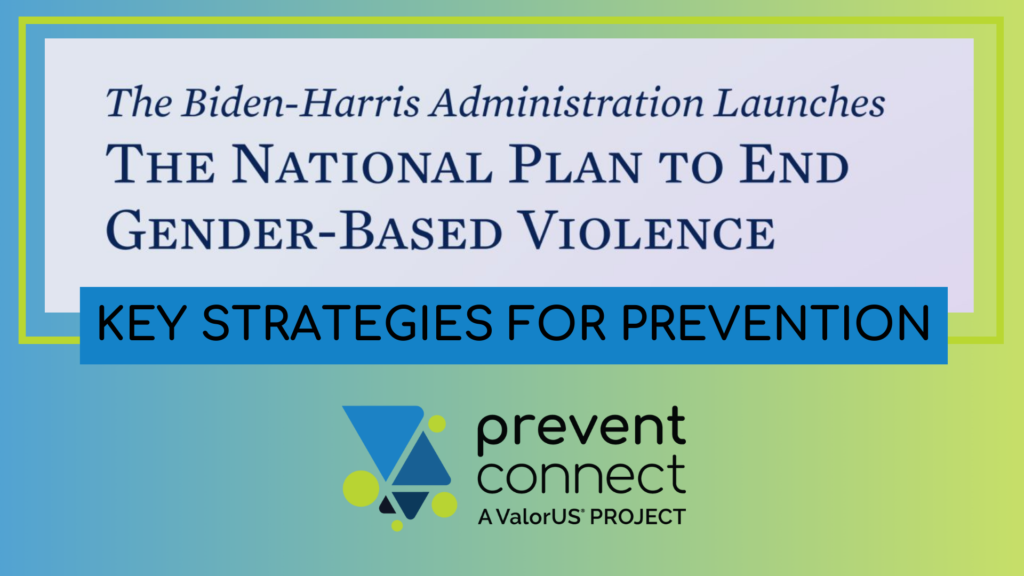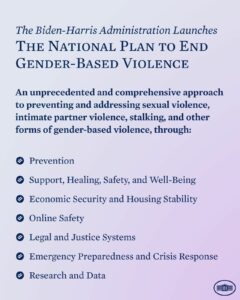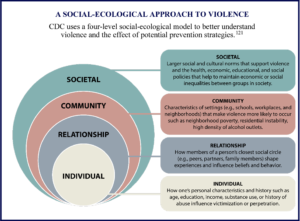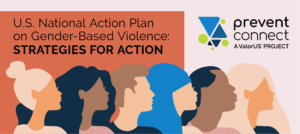White House focuses on prevention in National Plan to End Gender-Based Violence

The White House Gender Policy Council centered on Prevention as one of the key pillars in the first-ever comprehensive approach to addressing sexual violence, intimate partner violence, stalking, and other forms of gender-based violence in the United States.
 The National Plan to End Gender-Based Violence, which was published in late May, builds on existing federal programs and fills the gaps where marginalized communities have been historically left out of the national response to gender-based violence. Specifically, the plan outlines prevention, racial justice, LGBTQI+ equality, intergenerational healing, community wellness, and social norms change as key priority areas in future research projects, policy and funding.
The National Plan to End Gender-Based Violence, which was published in late May, builds on existing federal programs and fills the gaps where marginalized communities have been historically left out of the national response to gender-based violence. Specifically, the plan outlines prevention, racial justice, LGBTQI+ equality, intergenerational healing, community wellness, and social norms change as key priority areas in future research projects, policy and funding.
In naming Prevention as a core strategy in ending violence, the plan stated effective prevention programs must be comprehensive, take a public health approach to preventing violence, and address risk factors that contribute to violence, like harmful social and gender norms, economic insecurity and adverse childhood experiences (ACES).
To improve federal efforts to prevent violence, the NAP laid out four specific goals:

Enhance and promote Gender-Based Violence Prevention
 Primary prevention is still a relatively new framework to the public. The National Plan encourages researchers, public officials and practitioners to bolster data and messaging around the efficacy of prevention, as well as evaluate the effectiveness of existing efforts to intervene and respond by:
Primary prevention is still a relatively new framework to the public. The National Plan encourages researchers, public officials and practitioners to bolster data and messaging around the efficacy of prevention, as well as evaluate the effectiveness of existing efforts to intervene and respond by:
- Improving research and data collection about the nature and scope of victimization and perpetration.
- Enhancing research to capture information in federal datasets on marginalized and underserved communities and vulnerable populations, while also ensuring safety and confidentiality in the appropriate collection and use of data.
- Strengthening prevention in agency plans and processes.
- Increasing public awareness about the root causes of gender-based violence, its societal impacts, and the value of prevention and early intervention.
Enhance dissemination and implementation of Gender-Based Violence Prevention Strategies
The National Plan encourages sharing CDC technical packages, which outline core strategies to reduce gender-based violence across wide audiences in educational, community and policy settings to educate stakeholders on what prevention looks like in practice. Specific actions include:
- Strengthen and scale efforts to disseminate and uplift prevention strategies identified in the CDC Technical Packages.
- Continue to develop and expand evidence base of what works to prevent gender-based violence.
Improve prevention efforts to change social norms that support or condone Gender-Based Violence
The third goal under the prevention pillar encourages practitioners and policy makers to engage youth, especially men and boys, as thought leasers and partners, to help identify emerging issues and adopt innovative solutions. Efforts include:
- Enhance education efforts that promote healthy and respectful relationships among children, youth, and young adults.
- Advance community-based solutions that work with multiple stakeholders, including men and boys, as essential participants in prevention.
Improve comprehensive health approaches to prevent Gender-Based Violence
While much of the prevention pillar focuses on primary prevention, which prevents violence from ever occurring in the first place, the National Plan specified that secondary prevention (intervening when violence has occurred and preventing it from happening again) is still an integral component to federal prevention efforts. The NAP identified healthcare providers as important partners in preventing and screening for gender-based violence, as well as providing trauma-informed care for people who disclose gender-based violence during a healthcare visit. To strengthen secondary prevention efforts, the NAP suggested:
- Improving health care approaches to prevent GBV and to help survivors heal.
You can read more about each of the goals and objectives under the prevention pillar in the National Plan to End Gender-Based Violence: Strategies for Action
Prevention was one of seven strategic pillars identified in the National Plan, which are intended to serve as a framework for federal agencies and other stakeholders and inform and guide research, policy development, program planning and service delivery.
The full set of pillars are:
- Prevention
- Support, Healing, Safety and Well-Being
- Economic Security and Housing Stability
- Online Safety
- Legal and Justice Systems
- Emergency Preparedness and Crisis Response
- Research and Data
_________________________________________________________________
The U.S. has authored several federal policy packages in response to gender-based violence, including the Violence Against Women Act (VAWA), the NAP advances a comprehensive, whole-of-government, and intersectional approach to preventing and addressing GBV in the United States.
The National Plan to End Gender-Based Violence was created over the past two years, and informed by survivors and practitioners, like PreventConnect and national technical assistance providers.
 In 2021, PreventConnect hosted a listening session, where prevention practitioners had the opportunity to educate policymakers about the needs for prevention to help inform the National Action Plan. Attendees spoke about the crucial need for prevention, not just intervention.
In 2021, PreventConnect hosted a listening session, where prevention practitioners had the opportunity to educate policymakers about the needs for prevention to help inform the National Action Plan. Attendees spoke about the crucial need for prevention, not just intervention.
- Read the summary of the listening session, here.
- Watch the recording of the listening session, here.
The U.S. National Action Plan on Gender-Based Violence comes from President Biden’s Executive Order on Establishment of the White House Gender Policy Council. Many other countries already have national action plans on gender-based violence, and the United Nations has a handbook for national action plans on violence against women. Some countries have had multiple plans, such as Australia’s fourth national action plan on gender-based violence where primary prevention is listed as the first National Priority.
